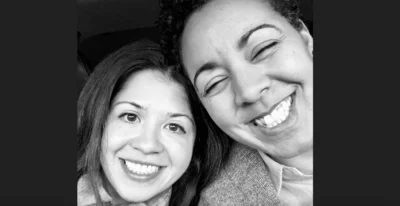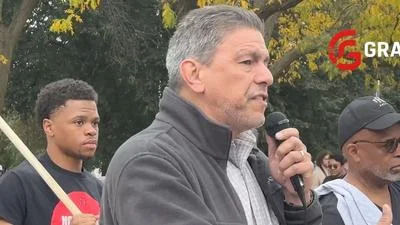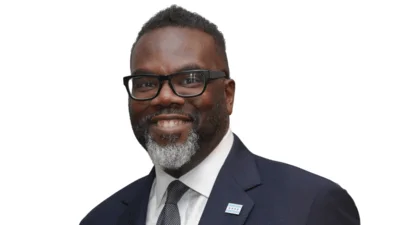iStock
iStock
To share the fun of Chicago River Day and help other volunteers make the most of their experience, father and son Tony and Andy Mitchell are teaming up for another year as co-site captains. Volunteer site captains play an important leadership role to organize and inspire volunteers, essential to making Friends’ largest annual event a success.
Excited to explore the river and get to know the people who volunteer, Tony and Andy have served as site captains at different locations all along river system. Together they captained sites at the North Avenue Turning Basin, Lathrop Homes, Skokie Northshore Sculpture Park adjacent to the North Shore Channel, and Canal Origins Park alongside Bubbly Creek in Chicago’s Bridgeport neighborhood. 2022 is their fifth year as co-site captains.
“We’re longtime volunteers going back to 2003 and we became site captains to get the even more enjoyment out of the day,” said Andy Mitchell. “Volunteers are excited to help so we guide them through the experience. We make a site visit the day before so we have a good sense of where volunteers can be of most use. It’s rewarding work for everyone involved, and my dad and I have a good system in place that makes it an easy-lift and a lot of fun.”
This year Friends rolls up our collective sleeves for the 30th Annual Chicago River Day on May 14, at over 60 locations from Lake County to southern Cook County, continuing Friends’ commitment to come together to make a litter free river system. Save the date and stay tuned in the coming weeks for site locations and details.
“We truly appreciate volunteers like Tony and Andy who embrace the leadership role of captains on Chicago River Day,” said Friends’ Volunteer, Events, and Canoe Program Manager Annette Anderson. “Their support picking up supplies, leading the cleanup, and reporting about their day is critical to organizing a successful event.”
If you are interested in helping as a captain, check out this one-page guide to learn more about the roles and responsibilities. First-year site captains can be paired with veterans who can show new volunteers the ropes. All captains will come together for training, tips and encouragement in March. Fill out our online form to let us know you are interested and receive more information.
Photo: Co-site captains Andy and Tom Mitchell (dressed in pink) with Chicago River Day volunteers at Canal Origins Park in Chicago.
An Opportunity for Water in Cities
On the new episode of Inside, Out & About we are joined by Mary Pat McGuire, associate professor of landscape architecture at the University of Illinois at Urbana-Champaign and director of Water Lab. McGuire talks about the relationship between water and pavement, and the vital need to rethink our overreliance on impervious paved surfaces. She details how we can undo the harmful environmental effects of paved surfaces by reducing their area, which creates positive impacts for human and ecological health, aesthetics, and resilience instead.
As a partner of the Chicago-Calumet River Watershed Council, McGuire’s expertise and leadership brings science, engineering, and design together to examine how we should live differently with water in urban areas like Chicago and create strategies to retrofit cities with nature-based green infrastructure and all of the benefits it brings with it.
In 2015, the Water Lab launched an ongoing design research project called Depave Chicago to transform the ground surfaces of the city into more ecologically and socially just environments. McGuire says Chicago has percentages of impervious ground that are among the highest in the country. Her research shows that “one third of the ground on the South Side of Chicago is paved and asphalted.” McGuire says it’s important to think of cities as “headwaters” to address the issues of flooding through nature-based solutions.
More episodes of Inside, Out & About are available on our website. This year we are expanding Inside, Out & About to feature people whose work inspires action and advocacy for the natural world; advancing ideas and strategies of how we can all work together to and improve and protect the river system for people, plants, and animals. In our first podcast series launched last year, we explored locations along the Chicago and Calumet rivers including the Chicago Portage National Historic Site, Bubbly Creek, and beautiful river-edge forest preserves.
Photo courtesy of Water Lab: Flooding on the South Side of Chicago
When the Falcon Looks at You
For avid birders Matt Greenberger and Julie Rand it was a sight to behold; a peregrine falcon, rustling in a tree at the Techny Basin in Glenview. Just as Greenberger was attempting to capture a photo, the raptor turned and looked directly at him – picture perfect. And as fast as he could snap a photo, the bird was gone, confirming timing is everything
Greenberger said spotting the falcon was a stunning example of the wildlife he sees regularly in the river system as a canoe guide for Friends of the Chicago River.
“You can live in Chicago and experience a natural outdoor life,” said Greenberger, who is starting his sixth season as a canoe guide this year. “Being a guide suited my love of the outdoors. It’s a great opportunity to introduce people to the river, and for people to experience wildlife from the water.” Over the years Greenberger has seen a barred owl, minks, muskrats, foxes, coyotes, beavers, and turtles of all kinds. He especially enjoys spotting duck species: mergansers, golden eyes, redheads, pintails, and more.
The peregrine falcon (Falco peregrinus) is the official bird of the city of Chicago, and is one of three falcon species that live in Illinois along with the American kestrel (Falco sparverius) and the Merlin (Falco columbarius). According to a Block Club Chicago story about peregrines in Chicago’s South Loop neighborhood, the raptors “can dive at 200 miles per hour, eating birds they capture — like pigeons — in mid-flight.”
The Field Museum’s Chicago Peregrine Program oversees Illinois' Peregrine Falcon population through nest monitoring, scientific research, and public education. According to the Field Museum, hundreds of peregrine falcons once nested in the region but by the 1960s the bird was wiped out in area due to DDT and other chemicals. It was placed on the endangered species list in 1973. Thankfully, from 1986 to 1990, the Chicago Peregrine Program released 46 peregrines at four different sites through the falconry process called hacking. The Chicago population has grown to 20 breeding pairs in more than 30 territories and the species was removed from the federal endangered list in 1999 and from Illinois’ list in 2014.
What wildlife have you spotted? Let us know and share your photos and videos of Chicago River system wildlife at wildlife@chicagoriver.org.
Photo: A peregrine falcon at Techny Basin on December 20, 2021 in Glenview (by Matt Greenberger).
Bill to Ban Foam Containers in Illinois
Passes First Step
A bill to ban disposable food containers made of polystyrene foam passed an important first step in the Illinois General Assembly last week. The House Energy and Environment Committee voted 16 to nine to move the legislation (HB 3067) from committee to the full House for consideration. Four state representatives on the committee did not cast votes
Friends' Policy Manager Chelsey Grassfield, who serves on the steering committee of the Coalition for Plastic Reduction which is advocating for the ban with Friends of the Chicago River, submitted a witness slip on behalf of Friends to the committee in support of this legislation. This is an important, early first step in the legislative process which requires the bill to be heard on the House floor for all representatives to vote on it, possibly next year. The bill is also pending in the Illinois Senate (SB 1973), but has yet to be heard in the Tourism and Hospitality Committee. We will keep provide updates as the bill moves through the legislative process which can move slowly
To help foster support for the bill, Friends put out a call on social media the day before the House committee hearing to encourage our supporters to submit witness slips supporting the legislation, and of the 306 slips the Committee received, 260 of those were proponents of the bill. While the volume of witness slips in favor of the bill was a great demonstration of support, contacting your lawmakers is the most impactful action you can take.
- Learn who your State Representative is.
- Is your Representative on the Energy and Environment Committee? Did they vote yea (thank them!) or nay (let them know why you would like them to vote in favor when it comes to the House floor.) If your Representative is not on the committee, ask them to vote in favor of the bill when it comes to the House floor.
- Learn who your State Senator is.
- Is your Senator on the Tourism and Hospitality Committee? Ask them to vote in favor of the legislation when it is heard in committee. If your Senator is not on the committee, ask them to vote in favor of the bill when it comes to the Senate floor.
- Learn more about engaging in the political process at the state level. Check out the Illinois Environmental Council’s Civics for Environmentalists series: Advocacy 101 and Legislative Procedure & Lobbying.
In Memoriam
Friends was saddened to learn of the passing of John Mach this month. The longtime president of the Hofmann Dam River Rats, John led the effort to persuade officials to remove the Hofmann and Fairbank dams on the Des Plaines River and partnered with Friends to restore a vital connection to Mill Creek to provide fish and mussel species access to high quality habitat.
A story about John in the Riverside-Brookfield Landmark reported: “Scoffed at early on for his insistence at improving the Des Plaines River ecosystem by removing the Hofmann and Fairbank dams, Mach eventually won over his doubters, gained the support of local, state and federal agencies and saw his dream come true in 2012. Just months after the dam’s removal, the Illinois Department of Natural Resources reported 20 species of fish in the formerly lifeless channel upstream of the dam’s former location.”
Friends’ Executive Director Margaret Frisbie said “John was a hard-working visionary who opened eyes to what's possible. He took me to Mill Creek and said we just need some money to remove a few steps. It was really tons of limestone and concrete, but we found the money and did it because John saw the potential. Almost immediately five new fish species moved upstream.”
We extend our condolences to John’s family and friends.
Photo: John Mach (by Kris DaPra)
Join Our Team to Improve and Protect the Chicago River System
Friends of the Chicago River seeks candidates for a full-time Director of Environment, Equity, and Engagement. An important member of Friends leadership team, the director of environment, equity, and engagement should be an experienced, creative leader who can build partnerships and expand Friends’ outreach to enhance public awareness, knowledge, skills, and attitudes that help improve the health of the Chicago River system and engage diverse audiences. More information about this position and the application process is available on Friends’ website.
Annual Report Details a Successful Year
Friends’ 2021 Annual Report is available on our website. The comprehensive report details Friends’ successful events and financial data from the past fiscal year (July 1, 2020 to June 30, 2021); covering our policy and planning initiatives, community engagement, habitat restoration, awards, stories of the year, supporters, and financial disclosures. Past copies of our annual reports are also available on our website.
Take Control of Your Neighborhood with the Natural Solutions Tool
The next virtual community partners meeting to help people learn more about the Natural Solutions Tool is 5:30 to 6:30 p.m. Monday, February 28. Register here. The meeting is hosted by the Chicago-Calumet River Watershed Council which is creating the tool. By combining sophisticated Geographic Information System analysis and on-the-ground input with community priorities, the Natural Solutions Tool will help communities and policy makers across the watershed integrate strategic equity and environmental considerations into the scopes of future projects to maximize their benefits for communities and the environment. Watch a video of the community partners meeting hosted on February 18 and come with questions and input at the next meeting on February 28.
Otter Research Project Needs Your Help
Otters are being spotted in Palos, Itasca, Lemont, and Evanston. The Urban River Otter Research Project – working closely with our partners at the Forest Preserves of Cook County – is evaluating how river otters are adapting to increased urbanization. You can help the otter project gather vital data by sending them information about any otter sightings you spot. They offer an easy-to-use online form. Learn more about this important wildlife project on our blog and read about it at The Hill online. And, be sure to share any otter photos/video (or any Chicago-Calumet river wildlife) with us at wildlife@chicagoriver.org.
Get to Know the North Branch Hiking Series
Our partners at Friends of the Forest Preserves (FOTFP) are hosting a year-long “Get to Know the North Brach Hiking Series" consisting of 15 hikes that showcase the different forest preserves of the North Branch of the Chicago River. The first hike is at 1 p.m. today at LaBagh Woods. Visiting most of the forest preserves along the North Branch, hikers will experience the unique flora, fauna, natural and human history, and the conservation efforts at each site. The hikes will be led by Derek Ziomber, the North Branch Field Organizer for FOTFP. See all the dates and register here.
312-939-0490






 Alerts Sign-up
Alerts Sign-up